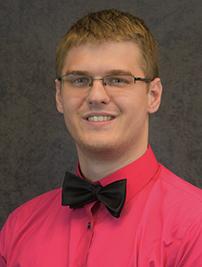 Roy Pillers is a Ph.D. student in mechanical engineering in Ted Heindel’s research group studying plunging liquid jets, work that has won multiple national awards and has potential for career-long study.
Roy Pillers is a Ph.D. student in mechanical engineering in Ted Heindel’s research group studying plunging liquid jets, work that has won multiple national awards and has potential for career-long study.
Award-winning discoveries
“Plunging liquid jets are the phenomenon of a stream of liquid entering a relatively stationary liquid pool, entraining gas due to the shear stresses at the edge of the jet. They are studied for the entrainment and mixing mechanisms that occur in the resulting bubble plume beneath the surface – and are a simple geometry that can be used to understand more complex phenomena such as ocean waves, waterfalls, fish farming, dams and other large hydraulic structures, waste treatment, and more,” Pillers said.
In 2021 Pillers’ research on plunging jets was recognized with three awards in national competitions. He received second place for a paper submitted to the ASME Fluids Engineering Division Summer meeting, another second-place award for a video submitted to the flow and visualization competition, and he was also a part of the team that submitted a video and won second place for the Who’s Who competition at the ASME Fluids Engineering Division conference.
The awards continued success Pillers has had success at ASME conferences. In 2020 he was awarded the prestigious Prof. Kirti Ghia Scholarship – and he was invited back to the conference under a returning graduate scholarship due to his involvement in Fluid Dynamics as a mentor and award winner.
Multiflow mentorship
According to Pillers, his success at the Fluids Engineering Conferences would not be possible without his major professor, Heindel, director of CoMFRE, University Professor of mechanical engineering, and Bergles Professor in Thermal Science.
“I chose Iowa State in particular because I was interested in working with Dr. Heindel, and I couldn’t be happier with my choice,” said Pillers. “Dr. Heindel has gone through countless revisions on these works with me, getting them to the polished state in which they are now published.”
Innovation in motion
Pillers also noted that certain flow and visualization projects are best conveyed through video or photos. He attributed part of his success in research competitions to the high-speed imaging equipment available in the lab.
Pillers said his experience with shooting and developing videos started with his time teaching classes remotely and made preparing a research video much more approachable.
“I went through multiple methods of recording and presenting with the help of a colleague on the College of Engineering communications team with extensive filming and photography skills,” said Pillers. “Through this process I improved significantly at video editing and my skills in front of a camera. After that, forming a quick research presentation felt a lot more comfortable.
Balancing act
As Pillers gets closer and closer to the key findings he’s seeking, the need for more and more data is necessary. Data collection requires a large amount of time, something Pillers said is always a balancing act between teaching and research.
Collaboration with others in his research group makes the balance possible.
“Without the help I have gotten from undergraduate and master’s students setting up my experiments and running code to process images, I would not be where I am today,” said Pillers.
Charting a path
According to Pillers, working on the project of plunging jets with the one-of-a-kind X-ray system has allowed him to select the path of research he wants to pursue long-term and has become a key part of his Ph.D. project.
“My goal is finding a teaching position at an undergraduate teaching college. While I may not have access to the same types of one-a-kind instruments I have here at Iowa State, this is still a project I can adapt to a different setting and continue making progress throughout my career,” Pillers said.